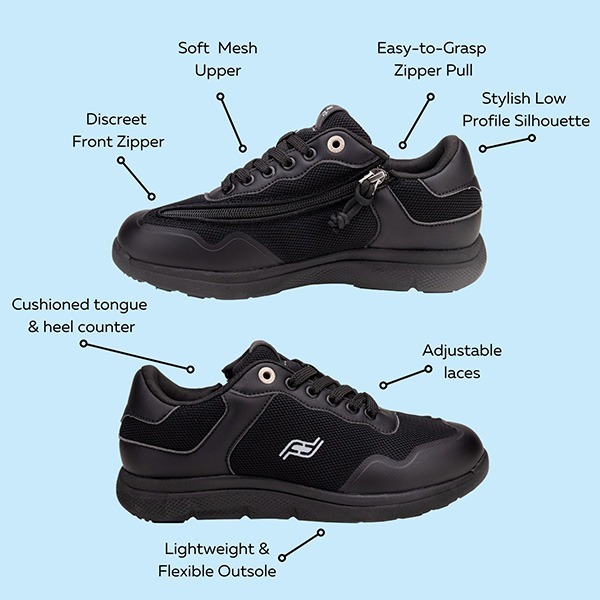Parkinson’s Disease Footwear Challenges
Finding proper shoes that fit your personal feet can be challenging. Are they comfortable? Are they stylish? Supportive? How do they look? Can I even get the shoes on?
We spend a large majority of our time in our shoes as we generally do not switch them out daily like we would a pair of socks or a t-shirt. Therefore, finding a shoe that accommodates our personal footwear needs can often be difficult.
Luckily, solving footwear challenges is what we do at Friendly Shoes, so with our team of Physical and Occupational Therapists, we decided to write about it!
In this article, we look at Parkinson’s Disease (PD) and what footwear challenges may arise, and some Friendly solutions to solve them.
Parkinson’s Disease can impact people in a variety of different ways. It is important to consider that symptoms may vary in each individual, especially in frequency, duration, and intensity of symptoms.
5 Different Stages of Parkinson’ Disease: (parkinson.org)
Stage 1:
Mild symptoms sometimes changes in walking, postures, and facial expressions. Generally do not interfere with activities of daily living (ADLs)
Footwear challenges: anticipate minor challenges, perhaps the onset of difficulties reaching down to feet for prolonged periods.
Friendly Solutions: Continue to keep moving with dynamic sitting and standing balance activities. Do not take assistance from others with tasks you are able to complete on your own, even if it is easier. Keep using it or lose it, faster.
Stage 2:
Symptoms tend to progress into a manifestation of tremors, rigidity, and/or other movement symptoms. Further decreased balance and postural alignment. ADLs may be modified, requiring more time and effort.
Footwear challenges: Desired movements may become more difficult, especially reaching your feet/laces. Fastening of laces may become difficult, reducing the ability to pull proper tension on shoes to optimize standing balance.
Friendly Solutions: Consider making modifications if needed during ADLs. Continue to do everything you can independently.
Stage 3:
Further reduction in balance and posture, overall movements become slow (bradykinesia), and tremors at rest increase. Considerable decline in ADL abilities however people are still able to complete daily tasks with increased time and modifications. Falls are common.
Footwear challenges: Slowing of movements, decreased postural control, and the onset of tremors can make shoe donning a non-shoe impossible. Fall risks are increased, consider the largest fall risk is a previous fall within the last 6 months.
Friendly Solutions: At this stage consider how to modify your activities ie. taking breaks, ADL environment set up such as where you place shoes, a step stool to assist, ect. Continue to remain active, keep a good open relationship with your MD, and immediately report if anything changes. Consider your medication schedule/timing and the best scheduling of daily tasks to get your best movements/outcomes.
Stage 4:
Symptoms become severe and limiting, hindering overall desired movements during ADL tasks. Standing may require assistance and/or an assistive device. ADLs require assistance. The sustaining individual is unable to live alone.
Footwear challenges: At this stage, individuals with PD may be able to complete some of the shoe-donning tasks however they may need some assistance. Beware the lure of slip-ons as these can increase the risk of falls.
Friendly Solutions: The individuals in this stage should continue to do as much as they can during their ADL routine. Make sure to work on sitting and standing balance and overall standing tolerance (how long can you stand without getting tired).
*Consider the overall volume of activities ie. you stood up 5 minutes x 3 times= 15 total minutes of task engagement
Stage 5:
The most debilitated final phase of the PD condition. Physical barriers such as leg stiffness, uncontrollable tremors, motor, and non-motor symptoms progress. This often results in complete dependence with ADLs.
Footwear challenges: At this stage, the shoe-donning/doffing task will be delegated to the family/caregiver.
Friendly Solutions: Ease caregiver assistance and continue to work on sitting and standing balance. This will assist in maintaining functional skills as well as decreased pressure from prolonged sitting/standing.
Transferring from bed to chair, from chair to standing to the toilet, etc. will be absolutely essential skills at this time. Proper footwear is essential in assisting the caregiver with sustaining the individuals’ ability to stand and pivot toward the desired transfer surface ie. wheelchair to toilet.
There are rating scales available @ www.parkinsons.org to help with the classification of staging. Please make sure to communicate any symptom changes and/or findings with your physician.







